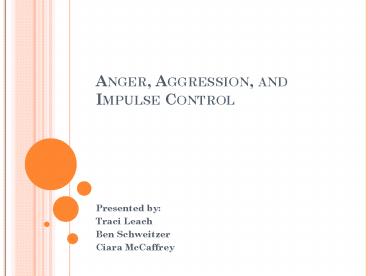Anger, Aggression, and Impulse Control PowerPoint PPT Presentation
1 / 8
Title: Anger, Aggression, and Impulse Control
1
Anger, Aggression, and Impulse Control
- Presented by
- Traci Leach
- Ben Schweitzer
- Ciara McCaffrey
2
Introduction
- Aggressive behaviors are species-typical
- Patterns of movements are organized by neural
circuits - Aggressive behaviors are often related to
reproduction - Types of aggressive behaviors include
- Threat Behaviors- posture gestures to warn the
adversary to leave it will become the target of
an attack - Defensive Behaviors- threat behaviors or an
attack against the animal that is threatening - Submissive Behaviors- accepting defeat and will
not challenge the other animal
3
Research with Laboratory Animals
- Neural control of aggressive behavior is
hierarchical - Whether an animal attacks depends on neural
circuits in the brain stem - Brain stem is controlled by the hypothalamus and
amygdala - When studying aggressive behaviors in cats, it
was determined that 3 regions of the amygdala and
2 regions of the hypothalamus affect defensive
rage and predation
4
The Role of Serotonin
- Serotonergic neurons have an inhibitory effect on
risky and aggressive behavior - A study with rhesus monkeys showed that lower
levels of serotonin were associated with higher
risk-taking behavior - Drugs that act as serotonin agonists have been
shown to reduce irritability and aggressiveness - Differences in the serotonin transporter gene
have been associated with varying reactions of
peoples amygdala when viewing facial expressions
of negative emotions
5
The Role of the Ventromedial Prefrontal Cortex
- This region of the prefrontal cortex is located
at the base of the anterior frontal lobes,
neighboring the midline. - It receives information from the dorsomedial
thalamus, temporal cortex, ventral tegmental
area, olfactory system, and amygdala. - The vmPFC sends information to several regions of
the brain, including the cingulated cortex,
hippocampal formation, temporal cortex, lateral
hypothalamus, and amygdala. All of this complex
communication provides information about the
surrounding environment. - This section of the brain is heavily responsible
for regulating how we respond to emotional
situations - It specifically inhibits violent behavior
provoked by the amygdala by accentuating the
negative consequences associated with it.
6
What Happens When the Ventromedial Prefrontal
Cortex is Damaged?
- Emotional behavior is directly impacted if the
vmPFC is damaged. - Perhaps the most famous example of this occurred
in the case of Phineas Gage, a foreman of a
railway construction crew. In 1848, he was using
a steel rod to apply blasting powder into a hole.
Unexpectedly, the charge exploded and the steel
rod entered his cheek, through his brain, and out
the top of his skull. Although he survived, his
personality completely changed. Before the
accident, he was described as being serious and
responsible. His vmPFC had been destroyed as a
result of the incident. For the remainder of his
life, he was prone to emotional outbursts and
seemed incapable of controlling his temper. - The vmPFC is largely responsible for balancing
the relationship between the automatic emotional
responses regulated by the amygdala and the
neural mechanisms involved in controlling complex
behaviors. Patients with damage to this region
have numerous emotional dysfunctions and
impairment in real-world competencies. Damage to
the vmPFC plays a large role in the formation of
moral judgment
7
Phineas Gage and his tamping iron
8
Treatment
- Impulsive Aggression has been successfully
treated using Serotonin Reuptake Inhibitors a
common example being Fluxetine or Prozac - Serotonin Reuptake Inhibitors increase the
activity of the prefrontal cortex and have shown
to reduce aggressive behavior

